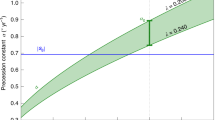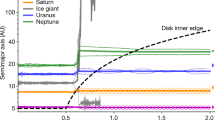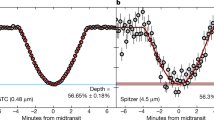Abstract
The existence of gaseous giant planets whose orbits lie close to their host stars (‘hot Jupiters’) can largely be accounted for by planetary migration associated with viscous evolution of proto-planetary nebulae1. Recently, observations of the Rossiter–McLaughlin effect2 during planetary transits have revealed that a considerable fraction of hot Jupiters are on orbits that are misaligned with respect to the spin axes of their host stars3. This observation has cast doubt on the importance of disk-driven migration as a mechanism for producing hot Jupiters. Here I show that misaligned orbits can be a natural consequence of disk migration in binary systems whose orbital plane is uncorrelated with the spin axes of the individual stars4,5,6. The gravitational torques arising from the dynamical evolution of idealized proto-planetary disks under perturbations from massive distant bodies act to misalign the orbital planes of the disks relative to the spin poles of their host stars. As a result, I suggest that in the absence of strong coupling between the angular momentum of the disk and that of the host star, or of sufficient dissipation that acts to realign the stellar spin axis and the planetary orbits, the fraction of planetary systems (including systems of ‘hot Neptunes’ and ‘super-Earths’) whose angular momentum vectors are misaligned with respect to their host stars will be commensurate with the rate of primordial stellar multiplicity.
This is a preview of subscription content, access via your institution
Access options
Subscribe to this journal
Receive 51 print issues and online access
$199.00 per year
only $3.90 per issue
Buy this article
- Purchase on Springer Link
- Instant access to full article PDF
Prices may be subject to local taxes which are calculated during checkout



Similar content being viewed by others
References
Lin, D. N. C., Bodenheimer, P. & Richardson, D. C. Orbital migration of the planetary companion of 51 Pegasi to its present location. Nature 380, 606–607 (1996)
McLaughlin, D. B. Some results of a spectrographic study of the Algol system. Astrophys. J. 60, 22–31 (1924)
Winn, J. N., Fabrycky, D., Albrecht, S. & Johnson, J. A. Hot stars with hot Jupiters have high obliquities. Astrophys. J. 718, L145–L149 (2010)
Ghez, A. M., Neugebauer, G. & Matthews, K. The multiplicity of T Tauri stars in the star forming regions Taurus-Auriga and Ophiuchus-Scorpius: a 2.2 micron speckle imaging survey. Astron. J. 106, 2005–2023 (1993)
Kraus, A. L., Ireland, M. J., Martinache, F. & Hillenbrand, L. A. Mapping the shores of the brown dwarf desert. II. Multiple star formation in Taurus-Auriga. Astrophys. J. 731, 8 (2011)
Marks, M. & Kroupa, P. Inverse dynamical population synthesis: constraining the initial conditions of young stellar clusters by studying their binary populations. Astron. Astrophys. 543, A8 (2012)
Hébrard, G. 20 colleagues The retrograde orbit of the HAT-P-6b exoplanet. Astron. Astrophys. 527, L11 (2011)
Wu, Y. & Murray, N. Planet migration and binary companions: the case of HD 80606b. Astrophys. J. 589, 605–614 (2003)
Fabrycky, D. & Tremaine, S. Shrinking binary and planetary orbits by Kozai cycles with tidal friction. Astrophys. J. 669, 1298–1315 (2007)
Naoz, S., Farr, W. M., Lithwick, Y., Rasio, F. A. & Teyssandier, J. Hot Jupiters from secular planet–planet interactions. Nature 473, 187–189 (2011)
Ford, E. B. & Rasio, F. A. Origins of eccentric extrasolar planets: testing the planet-planet scattering model. Astrophys. J. 686, 621–636 (2008)
Nagasawa, M., Ida, S. & Bessho, T. Formation of hot planets by a combination of planet scattering, tidal circularization, and the Kozai mechanism. Astrophys. J. 678, 498–508 (2008)
Wu, Y. & Lithwick, Y. Secular chaos and the production of hot Jupiters. Astrophys. J. 735, 109 (2011)
Guillochon, J., Ramirez-Ruiz, E. & Lin, D. Consequences of the ejection and disruption of giant planets. Astrophys. J. 732, 74 (2011)
Morbidelli, A. & Crida, A. The dynamics of Jupiter and Saturn in the gaseous protoplanetary disk. Icarus 191, 158–171 (2007)
Marquis de Laplace, P.-S. Traite de Mecanique Celeste, 1 and 2 Vol. 1, Ch. VII, 569–634, http://ia600303.us.archive.org/19/items/mcaniquecles01laplrich/mcaniquecles01laplrich.pdf (Hillard, Gray, Little and Wilkins, 1799)
Gauss, C. F. Theoria Motus Corporum Coelestium in Sectionibus Conicis Solem Ambientium (eds Perthes, F. & Besser, I. H. ) (Sumtibus, 1809); in Werke Vol. 3, 331–355, http://resolver.sub.uni-goettingen.de/purl?PPN235999628 (Dieterich, Gottinger, 1866)
Murray, C. D. & Dermott, S. F. Solar System Dynamics Ch. 7 (Cambridge University Press, 1999)
Touma, J. R., Tremaine, S. & Kazandjian, M. V. Gauss’s method for secular dynamics, softened. Mon. Not. R. Astron. Soc. 394, 1085–1108 (2009)
Batygin, K., Morbidelli, A. & Tsiganis, K. Formation and evolution of planetary systems in presence of highly inclined stellar perturbers. Astron. Astrophys. 533, A7 (2011)
Morbidelli, A. Modern Celestial Mechanics: Aspects of Solar System Dynamics Chs 4 and 8 (Taylor and Francis, 2002)
Herbst, W., Bailer-Jones, C. A. L., Mundt, R., Meisenheimer, K. & Wackermann, R. Stellar rotation and variability in the Orion nebula cluster. Astron. Astrophys. 396, 513–532 (2002)
Calvet, N. et al. Disk evolution in the Orion OB1 association. Astron. J. 129, 935–946 (2005)
Kaib, N. A., Raymond, S. N. & Duncan, M. J. 55 Cancri: a coplanar planetary system that is likely misaligned with its star. Astrophys. J. 742, L24 (2011)
Kraus, A. L. & Hillenbrand, L. A. The role of mass and environment in multiple-star formation: a 2MASS survey of wide multiplicity in three young associations. Astrophys. J. 662, 413–430 (2007)
Adams, F. C. The birth environment of the Solar System. Annu. Rev. Astron. Astrophys. 48, 47–85 (2010)
Bate, M. R., Lodato, G. & Pringle, J. E. Chaotic star formation and the alignment of stellar rotation with disc and planetary orbital axes. Mon. Not. R. Astron. Soc. 401, 1505–1513 (2010)
Lai, D. Tidal dissipation in planet-hosting stars: damping of spin-orbit misalignment and survival of hot Jupiters. Mon. Not. R. Astron. Soc. 423, 486–492 (2011)
Terquem, C. & Papaloizou, J. C. B. Migration and the formation of systems of hot super-Earths and Neptunes. Astrophys. J. 654, 1110–1120 (2007)
Lissauer, J. J. et al. Architecture and dynamics of Kepler’s candidate multiple transiting planet systems. Astrophys. J. Suppl. Ser. 197, 8 (2011)
Acknowledgements
I thank A. Morbidelli, P. Golreich, H. Knutson, S. Tremaine, J. Winn and F. Adams for numerous conversations and D. Stevenson and G. Laughlin for carefully reading the manuscript. I am greatly indebted to M. Kazandjian and J. Touma for providing me with the softened analytical Gaussian averaging algorithm used in this work and help with implementation. Finally, I am grateful to D. Fabrycky for careful examination of the paper and numerous suggestions, which resulted in a substantial improvement of the manuscript.
Author information
Authors and Affiliations
Corresponding author
Ethics declarations
Competing interests
The author declares no competing financial interests.
Supplementary information
Supplementary Information
This file contains Supplementary Text and Data 1-4, Supplementary Figures 1-6 and additional references. (PDF 1408 kb)
Rights and permissions
About this article
Cite this article
Batygin, K. A primordial origin for misalignments between stellar spin axes and planetary orbits. Nature 491, 418–420 (2012). https://doi.org/10.1038/nature11560
Received:
Accepted:
Published:
Issue Date:
DOI: https://doi.org/10.1038/nature11560
This article is cited by
-
Stellar clustering shapes the architecture of planetary systems
Nature (2020)
-
A warped disk around an infant protostar
Nature (2019)
-
Formation, Orbital and Internal Evolutions of Young Planetary Systems
Space Science Reviews (2016)
Comments
By submitting a comment you agree to abide by our Terms and Community Guidelines. If you find something abusive or that does not comply with our terms or guidelines please flag it as inappropriate.



